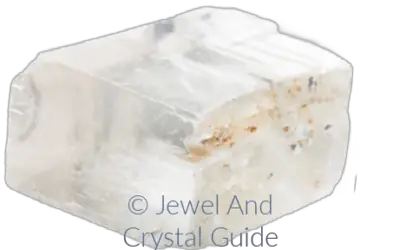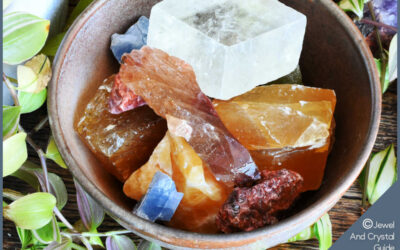Aventurine and amazonite are both beautiful green crystals, but they do have distinct differences in texture, luster, and overall appearance when you know what to look for…
Raw aventurine has a grainy or sugary texture due to minerals that often sparkle or shimmer under light. Amazonite has a smooth and uniform look with a glassy sheen. Aventurine can be shades of green and other colors, but amazonite is always greenish-blue to green, like tropical waters.
Let’s explore what makes aventurine different from amazonite, and how you can test a piece to tell which one it is.
In this blog post, you’ll discover:
- The differences between aventurine and amazonite
- A table summarizing the differences between aventurine and amazonite
- How to test for aventurine and amazonite
The differences between aventurine and amazonite
Here’s a list of differences between aventurine and amazonite…
Aventurine is quartz, amazonite is feldspar
Aventurine is quartz crystal, made up of silicon and oxygen, with other mineral inclusions, like fuschite. Amazonite is a type of feldspar called microcline, and it’s mainly made up of potassium, aluminum, silicon, and oxygen.
Aventurine:
Quartz crystals form in the Earth’s crust and are one of the most abundant minerals on our planet. If you look at quartz under a microscope, you’ll see that it has a repeating pattern, which gives it a crystal structure.
Quartz crystals are hard and stable as they can withstand high temperatures and chemical reactions, which is why they’re commonly found in many types of rocks.
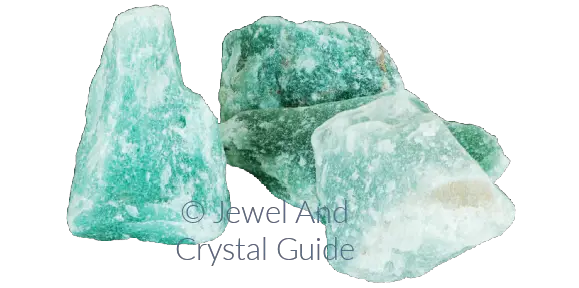
Amazonite:
Feldspar is a family of minerals that are abundant in the Earth’s crust, found in different types of rocks. They are composed of a combination of aluminum, silicon, and oxygen, along with other elements like potassium, sodium, calcium, or barium.
Amazonite is a microcline feldspar, which is a hard potassium variety.
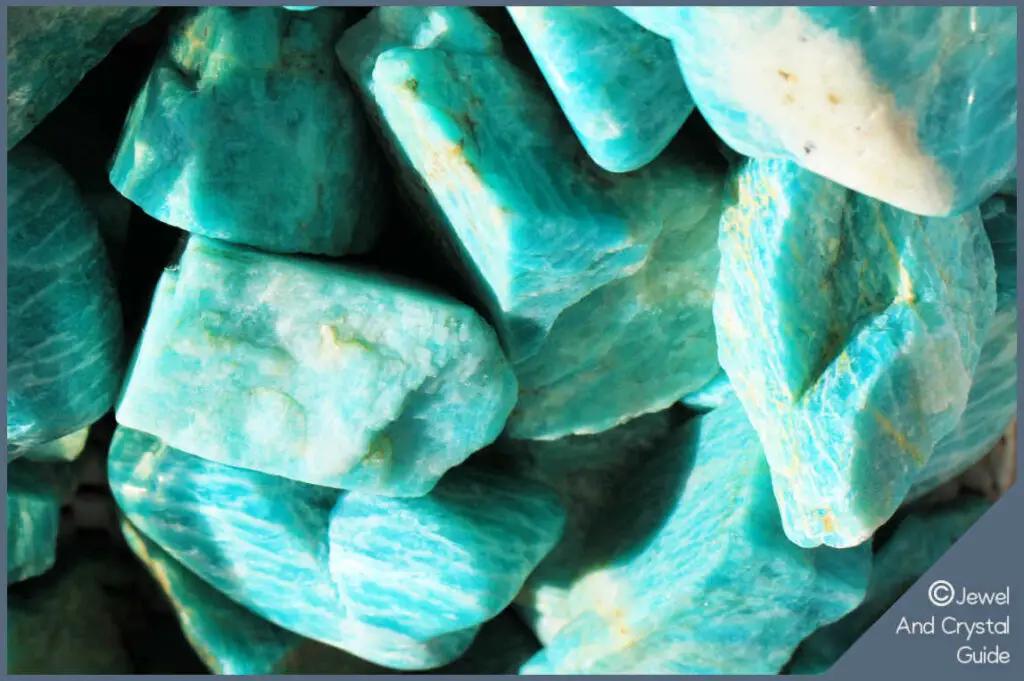
Get a full overview of amazonite crystals and links to my other relevant articles in this guide.
Different minerals make aventurine and amazonite green
Fuschite makes aventurine green, while lead and water turn amazonite green.
Aventurine:
Aventurine has small inclusions of minerals in it, usually fuchsite or hematite. These inclusions give aventurine a shimmering effect called aventurescence, but they also give it color.
Fuchsite is a green-colored mineral that contains chromium. The more fuschite is in a piece of aventurine, the greener the piece looks and the more it shimmers.
Amazonite:
Trace amounts of lead in an amazonite crystal give it a distinct green or blue-green color.
Experts aren’t sure why or how small quantities of lead turn amazonite green, but many think the lead interacts with light, absorbing some wavelengths and reflecting the colors green and blue-green.
Read all about how amazonite forms and why it’s green (and white) in this blog post.
Aventurine comes in different colors, amazonite doesn’t
Most aventurine is green, ranging from light to dark depending on how much fuschite is in the crystal. But aventurine also comes in other colors, such as red or orange when hematite is present, and blue when dumortierite or blue quartz is there.
Aventurine can also have white or light-colored areas. These are usually from mineral inclusions, most commonly quartz or feldspar.
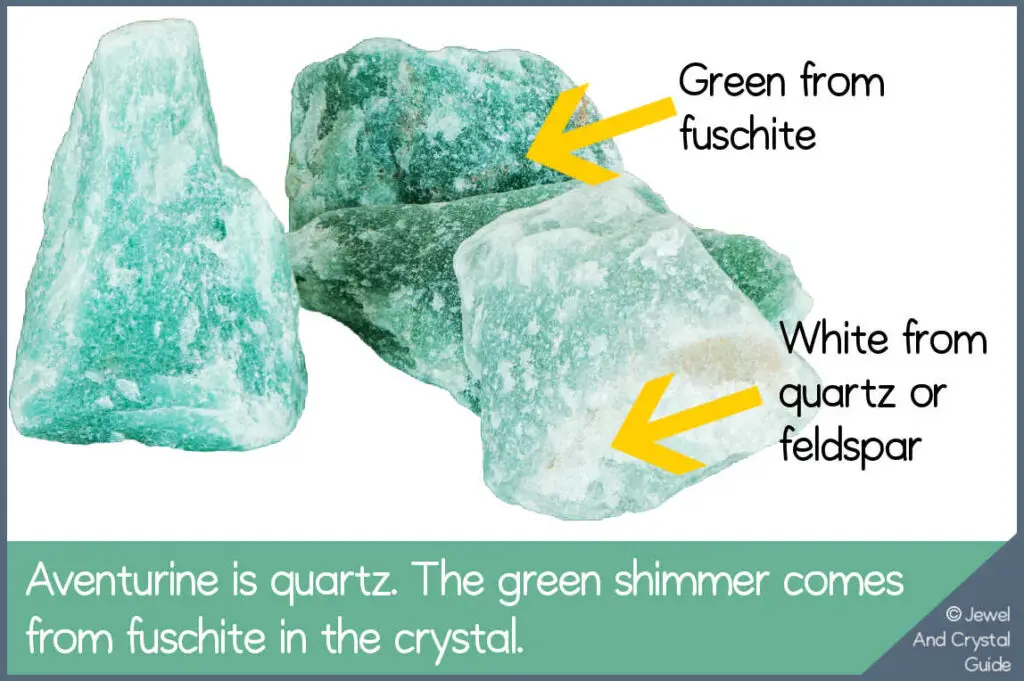
Amazonite has a characteristic blue-green or bluish-green color. The exact shade varies from pale blue-green to a deeper, more intense green-blue hue. Different concentrations of trace elements in the amazonite, particularly lead, influence the color and give it a range of blue-green hues.
Amazonite is known for having white streaks, patches, or banding in it. The white portions are usually from a mineral called albite, another type of feldspar.

Aventurine and amazonite have very different textures
Aventurine has a sugary or grainy texture, while amazonite has a smoother and more polished feel to it. This difference in texture can be observed by running your fingers along the surface of the stones.
Aventurine often has a texture that is referred to as “sugary” or “gritty.” When you touch aventurine, it can feel slightly rough or grainy, similar to the texture of sugar or fine sand. This texture is from tiny mineral grains or inclusions in the quartz matrix. They create a granular texture when observed closely or felt with the fingertips.
Amazonite has a smoother texture than aventurine. When you touch amazonite, it feels quite sleek and smooth, and the surface can have a slight waxy or pearly luster.
Aventurine and amazonite form in different shapes
Aventurine usually grows in hexagons with six sides. The quartz often forms as small, interlocking crystals, creating a compact structure.
Amazonite has a triclinic structure, with a smooth texture and a less angular or symmetrical crystal shape. Amazonite forms as blocks with irregular-shaped crystals.
Aventurine and amazonite have different levels of transparency
The transparency of aventurine and amazonite is affected by things like the crystal’s quality, clarity, inclusions or impurities, cut, etc.
Aventurine is typically translucent to opaque – light can pass through it, but it is not transparent enough to clearly see objects or images through the crystal.
Amazonite is usually more transparent than aventurine, allowing more light to pass through it.
Aventurine and amazonite come from different places
The occurrence of both aventurine and amazonite is closely tied to geological processes. They are often associated with pegmatites, which are coarse-grained igneous rocks that form from the slow cooling of magma. Pegmatites provide the ideal conditions for the growth of larger crystals, including quartz and feldspar, which are the primary constituents of aventurine and amazonite.
Aventurine is found in:
- India: Aventurine is often sourced from various regions in India, including Rajasthan and Tamil Nadu. The deposits in these areas are known for their green aventurine varieties.
- Brazil: Brazil is another significant source of aventurine. It is found in different Brazilian states, such as Rio Grande do Sul and Bahia.
- Russia: Aventurine deposits are found in Russia, particularly in the Ural Mountains region. The Ural Mountains have a rich geological heritage and are known for their green aventurine.
- South Africa: Aventurine is also found in South Africa, primarily in the Northern Cape province.
Notable deposits of amazonite are found in:
- Brazil: Brazil is a major source of amazonite, particularly from the state of Minas Gerais.
- Russia: Amazonite deposits can be found in Russia, specifically in the Murmansk region and the Kola Peninsula.
- United States: Amazonite is also found in the United States, with notable sources in Colorado, New Mexico, and Virginia. These regions have pegmatite deposits that contain amazonite. In the United States, amazonite is often associated with other minerals like smoky quartz and albite.
- Madagascar: Madagascar is another country where amazonite can be found. It is known for its distinctive blue-green amazonite specimens.
Aventurine and amazonite can be found in other locations as well, and the availability of these crystals varies over time.
Aventurine and amazonite are good for different things
Aventurine is believed to bring:
- Luck and Prosperity: Aventurine is often seen as a stone of luck and abundance. It attracts opportunities and helps manifest good fortune and financial success.
- Emotional Healing: Aventurine is linked to emotional healing and promotes a sense of well-being. It helps release negative emotions, calms anxiety, and enhances inner peace.
- Heart Chakra Activation: Aventurine stimulates and balances the heart chakra, fostering compassion, empathy, and harmonious relationships.
- Creativity and Motivation: Aventurine enhances creativity, motivation, and perseverance, making it popular among artists, entrepreneurs, and anyone looking for a little inspiration.
Amazonite is good for:
- Communication and Harmony: Amazonite supports clear and confident communication, both in personal relationships and in expressing oneself creatively. It enhances interpersonal communication and promotes harmonious interactions.
- Emotional Balance: Amazonite soothes and calms the emotions, helping with stress relief, anxiety reduction, and emotional healing. It also promotes a sense of balance, serenity, and inner peace.
- Truth and Integrity: Amazonite is associated with truthfulness, integrity, and self-expression. It encourages honest communication and aligns one’s actions with one’s values.
- Intuition and Psychic Abilities: Amazonite is sometimes linked to enhancing intuition, psychic abilities, and spiritual insight. It heightens awareness and connection with higher realms of consciousness.
Amazonite is more valuable than aventurine
In general, amazonite is more valuable than aventurine. Amazonite’s popularity, unique color, and limited availability contribute to its relatively higher value in the market. Aventurine is generally considered a more affordable crystal as there’s more available and less demand for it.
However, it’s good to remember that the value of crystals depends on things like color, clarity, size, and origin. Prices can also fluctuate over time due to supply and demand.
The following table gives an idea of what aventurine and amazonite cost per gram (USD) according to grade:
| Low Grade | Medium Grade | High Grade | |
| Aventurine | $0.10 – $1 per gram | $1 – $5 per gram | $5 – $20+ per gram |
| Amazonite | $2 – $6 per gram | $4 – $16 per gram | $10 – $30+ per gram |
Table of differences between aventurine and amazonite
The table below is a quick guide to all the differences between aventurine and amazonite that I explained in detail above:
| Property | Aventurine | Amazonite |
| Composition | Quartz crystal | Feldspar |
| Color | Green (from fuschite), red, orange, blue | Green or blue-green (from lead) |
| Texture | Sugary or grainy | Smooth and waxy |
| Crystal Shapes | Hexagons with six sides | Blocks with smooth sides |
| Transparency | Translucent to opaque | Higher transparency |
| Origin | India, Brazil, Russia, South Africa | Brazil, Russia, USA, Madagascar |
| Good For | Luck and prosperity, emotional healing, heart chakra activation, creativity and motivation | Communication and harmony, emotional balance, truth and integrity, intuition and psychic abilities |
| Value | Less valuable | More valuable |
How to tell if a piece if aventurine or amazonite
While professional testing is the most accurate way to determine whether a piece is aventurine or amazonite, here are a few simple tests you can do to gather some initial information:
Visual Examination:
Look closely at the color of the crystal.
Aventurine is commonly green, but it can also occur in other colors like red, orange, brown, and blue. It can have white in the crystal.
Amazonite is known for its distinct blue-green color, often with bands, stripes, or areas of white.
Streak Test:
Get a piece of unglazed porcelain tile or a ceramic plate. Rub the crystal firmly against the tile or plate using moderate pressure.
Look at the color of the streak left behind on the tile or plate.
Aventurine usually leaves a light-colored streak on the tile or plate, reflecting its color. For example, green aventurine leaves a light green streak.
Amazonite usually leaves a white streak, no matter what blue-green color the crystal is.
Transparency Test:
Hold the stone against a light source, such as a flashlight or sunlight, and look at how much light passes through it.
Aventurine is generally more opaque or translucent, allowing little or no light to pass through.
Amazonite tends to have more transparency, allowing more light to pass through it.
Visual Features:
Examine the stone for any visible inclusions or distinctive patterns.
Aventurine often contains small sparkly mineral inclusions that give it a shimmering or glittery appearance.
Amazonite usually appears more uniform and shines a lot, like a pearl. It doesn’t shimmer, like glitter.










